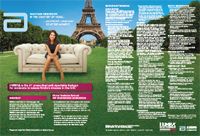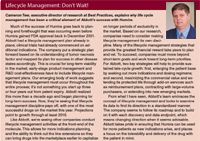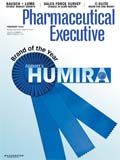Best to Market
Pharm Exec's Brand of the Year: Abbott's Humira
Rich data on the clinical side, combined with flexible marketing and outreach to payers, have pushed Humira to the top ranks of powerhouse drugs. With five more years of exclusivity, patients are waiting for more.

(GETTY IMAGES / C SQUARED STUDIOS)
More than a few biotechs, and most Big Pharmas, are exploring next-generation drug candidates in one of the hottest therapeutic areas: autoimmune conditions such as rheumatoid arthritis, psoriasis, and Crohn's disease. A crowded market for these large indications hasn't prevented newer drugs from receiving the regulatory green light in the U.S. and abroad, but in the short term, it's unlikely that any will unseat the towering giants in the space: Remicade, Enbrel, and Pharm Exec's Brand of the Year, Humira. These three drugs have combined sales exceeding the entire GDP of Afghanistan, and demand continues to mount, because for patients, they can mean the difference between a crippling disability and a relatively normal existence.
Johnson & Johnson/Merck's Remicade, administered by infusion, was the first anti-TNF to receive FDA approval—for acute moderate to severe Crohn's disease—while Amgen/Pfizer's Enbrel was the first to be approved for rheumatoid arthritis. Both approvals came in 1998. Abbott Laboratories' Humira didn't get approved until New Year's Eve 2002, but its product directors clearly made timely resolutions to celebrate. Abbott's bold promotional stewardship of the drug with respect to payers, patients, and evidence-driven medicine, combined with Humira's sheer clinical efficacy and success in gaining new indications where the others have not, are the reasons why Pharm Exec singled out Humira for brand leadership. Analysts are predicting that Humira's sales will surpass Lipitor's as the top-selling medicine ever, and there's a likelihood that even more indications will be added to the label. So Humira may not have been the first to market, but we think it was the best to market.
Ten years after launch, Humira continues to grow. Last month, Abbott reported a global growth rate of 21.1 percent (19.3 percent in the U.S.) for Humira, with total sales at $7.9 billion ($3.4 billion in the U.S., and $4.5 billion internationally) in 2011. On the full-year 2011 earnings call, Abbott execs touted Humira's breadth of indications, strong long-term safety and outcomes data, as well as its strength in managed markets and a record of superior clinical efficacy. Responding to an analyst's question on new competitors, including the development of oral products, Abbott CEO Miles White noted that Humira "has seen competition" in the past, and has continued to succeed. The drug "continues to shine in its overall profile," he said.
Jeffrey Stewart, Abbott's vice president of U.S. proprietary pharmaceuticals, says the fundamental talents at Abbott revolve around anticipating the market, and then executing on strategy. "When you think about the three biggest indications—RA, psoriasis, and Crohn's—our indication set is the closest match to the market. RA and the rheumatological conditions remain the largest segment, but Crohn's and psoriasis are growing the fastest," says Stewart. Humira currently has six indications—RA, juvenile idiopathic arthritis, psoriatic arthritis, ankylosing spondylitis, Crohn's, and plaque psoriasis—and has plans for more. At JP Morgan's 30th Annual Healthcare Conference last month, Thomas Freyman, executive vice president, finance, and chief financial officer at Abbott, described Humira as a "cornerstone" of the proprietary pharma business, one he expects to provide "strong and sustainable growth" for the new pharmaceuticals division. (Abbott announced plans to split its drug and medical device products into two separate businesses, explained in further detail below.) Abbott is "evaluating Humira in a number of additional indications, which we expect to collectively generate significant incremental sales," said Freyman. Additionally, "low global penetration rates for biologics create a significant opportunity to drive longer-term sustainable growth ... we're focused on expanding the anti-TNF market, and the Humira patient base, as well as improving patient adherence," he said.
Indeed, an increased penetration of the anti-TNFs in global markets does represent an opportunity, says Barbara Ryan, managing director, Deutsche Bank Securities. "Humira is growing faster outside of the U.S.," she says. Stewart spotlights Brazil as "one of the fastest-growing areas for Humira ... It has become a very significant driver for us; the reimbursement rate is positive—the Abbott people down there are doing quite nicely with Humira," he says.
The most dramatic example of a global opportunity, according to Stewart, is in the psoriasis indication. "We're talking about penetration rates around 5 percent to 10 percent of the indicated patients with moderate-to-severe psoriasis; that's not market expansion or a new indication around mild psoriasis—we're not going for that—but it's amazing to think that there's another 80 percent to 90 percent, within the indication," says Stewart. Full market penetration may be a little unrealistic, given that the anti-TNF class has been around for over a decade, but "when you look at the new indications, and the relative penetration rate, it gives you a lot of cause for optimism," says Stewart.
Strength in Numbers
Enbrel doesn't have an indication for Crohn's disease, and Remicade never established a foothold in dermatology, so Humira's full coverage of all three represents a distinct advantage. But perhaps one of the most valuable cards in Humira's deck is the numbers, in the form of long-term clinical studies. "We've kept a lot of our studies going on for an extended period of time," says Stewart. "In RA, we're proud to be able to highlight eight years of showing that the joints are stable, that the joints don't deteriorate over time. That's a substantial time frame, unique to Humira, and that allows our representatives to frame out why Humira might be the best option for patients." Stewart says the management of clinical data collected over time is beneficial for all stakeholders. "Years ago, these biologics were somewhat mysterious, but I think that because of the breadth of our clinical program, and the huge safety database that we have, no matter who you are—a payer, or a prescriber, or a patient—the fact that we have that data gives them comfort," says Stewart. "These are severe diseases, and patients are often in rough shape, so that extensive database, going back to 1997, when we enrolled the first patients, is a significant asset."

Jeffrey Stewart, VP
Stewart points to dermatology as an example of how managing and communicating the data translates into better sales figures. "There's never been head-to-head trials between Enbrel and J&J's Stelara (approved in 2009 for moderate to severe plaque psoriasis), but if you look at the perception among doctors, and you look at the market research, the skin clearance that we see in our pivotal trials—the ability to clear plaque psoriasis from 75 percent of the body—it's pretty much universally viewed as very impressive efficacy data," says Stewart. "That helps us out with the overall perception of Humira as a safe biologic, in addition to the experience in the marketplace since 2003, even with other indications. In 2011, we became the new prescription and the total prescription market share leader in dermatology, and gained almost three share points. The market is rewarding us for our profile and our ability to communicate the Humira data."
Fear Factor
Humira is not without serious potential side effects, though, which holds true for the rest of the anti-TNF class. They all carry FDA's sternest safety warning—the Black Box—which can be hair-raising for patients. Virginia Ladd, president and executive director of the American Autoimmune Related Diseases Association (AARDA), says patients have a real "fear factor" when it comes to the anti-TNF class. "Lymphoma—they hear that, they hear cancer in the advertisements, life-threatening infection, tuberculosis ... you have to be pretty brave," says Ladd.
In a forthcoming paper and patient brochure, AARDA will reveal the results of a study conducted among 1,000 autoimmune patients, and how they make the decision to receive treatment. Ladd says most pharmaceutical companies she deals with do a pretty good job of educating patients on the risks and benefits of a drug, and Abbott "does an excellent job—they have websites, they have webinars, and all kinds of things that are patient-friendly, that help patients." However, the study results showed that pharmaceutical companies aren't too high on the list of trustworthy sources of information. Ladd says this isn't entirely pharma's fault. "Many patients with autoimmune diseases do not actually trust their doctors," says Ladd. "The reason for this is that most have had a difficult time being diagnosed. They saw several doctors, and over 40 percent were told—these were patients with serious autoimmune diseases—that they were chronic complainers or too concerned with their health." Symptoms such as fatigue and joint pain, and the fact that RA in particular affects women disproportionately, has led to problems with diagnosis. "These women are told they're too busy or too stressed, or they're depressed. So when they actually do get a diagnosis they're grateful ... but when the doctor tells them, 'I want you to take this TNF-inhibitor,' they see the ads, and there's a level of mistrust to begin with," says Ladd.
For physicians, Ladd has some advice: Tell the patient what the side effects of their illnesses are, in addition to drug side effects. During the study, Ladd said AARDA tested responses to physicians' instructions, in terms of how patients behaved. In each scenario, a patient has been diagnosed with RA, and given a script for an anti-TNF. In the first scenario, the doctor says, "Here's your prescription; see me in three months." In a different test, the doctor says, "Here's your prescription for rheumatoid arthritis, which we hope will prevent the crippling that could cause a disability in you." In the latter instance, "compliance shot up," says Ladd. "I call it three-second compliance. If a physician adds three seconds, patients know what the drug is going to do for them. If it's going to halt something, if it's going to stop progression—that was very important to patients."
When diagnosed early, RA patients who receive anti-TNF treatment immediately can prevent crippling and disability, and that's one of the best aspects of the drugs, says Ladd. Biologics like Humira "are the only really new medications to come along for most autoimmune diseases in 50 years ... they represent a real advance in the treatment of these conditions," says Ladd.
Cost Conundrum
Even for patients with insurance, access to Humira requires a "very rigorous" prior authorization process, says Stewart. Before paying for the drug, insurance companies have to verify the patient is authorized and has the corresponding benefit, and that the indication is on-label—and that can take time. Given the value of each new Humira patient, Abbott has endeavored to expedite the process, and make it easier for patients to get access to the drug. "We have a reimbursement hub that enables doctors and patients to call and find out if a given insurance benefit will cover Humira," and that gives patients an idea about what their copay might be, says Stewart. Copays can be substantial, particularly with plans that use co-insurance for expensive biologics; with co-insurance, the patient pays a percentage of the total cost, rather than a set rate. Private insurance plans have increasingly moved from copays to co-insurance to lower costs—Stewart estimates that 20 percent to 25 percent of commercial plans use co-insurance—and that means patients are on the hook for a bigger chunk of the cost.

Abbott’s interactive ‘virtual doctor’ feature lets website visitors practice the conversation they may have at the doctor’s office.
To help patients hurdle the cost barrier, Abbott created the Humira Protection Plan, which offers financial assistance to those who need it. If a patient is employed and has a prescription drug benefit, the company "can reduce your copay to $5 month," according to the program website. Unemployed and/or uninsured patients may also be able to get the drug at no cost, through the Abbott Patient Assistance Foundation, assuming they meet the requirements. The Foundation provides assistance for Abbott products only, but since methotrexate has been shown to improve the efficacy of Humira, other independent copay foundations can provide additional assistance. By law, Abbott can't assist patients under Medicare Part D. Stewart says Humira's market share under classic Part D is lower than its share in the commercial insurance market. "We've hypothesized that a lot of that is due to the varying incentives of a medically reimbursed infusion," which is covered under Medicare Part B, and many Part D patients "often have high co-pays initially, and then are very likely to hit the donut hole," says Stewart. The financial incentives for physicians around medically reimbursed agents, particularly infusion versus subcutaneous injection, and the corresponding Medicare benefits, contain "a lot of complexities that patients have to navigate," says Stewart.

In 2011, Abbott spoke directly to consumers "like never before," while still maintaining communication with physicians.
Regarding financial assistance, Ladd says most of the available programs, including Abbott's, "really help in cases of need ... some of them are very generous." But financial assistance programs can only be used for approved, on-label conditions. Ladd says a lot of patients get off-label scrips for anti-TNFs—for example, an autoimmune eye disease that can cause blindness—but in that case, Abbott can't provide the drug or assist with the cost, and insurance companies won't cover it either.
New Indications
Will Abbott be able to maintain double-digit growth for the next five or so years, until the patent expires? It's very doubtful that any new indication for Humira will be as lucrative as the RA, Crohn's, or psoriasis indications, but a couple new additions to the label means incremental growth. Stewart says six new indications are on the docket: hidrandenitis suppurativa (a fulminating inflammatory skin disease); uveitis (an eye inflammation that can lead to permanent vision loss); axial and peripheral spondyloarthropathies, or SpA (two indications covering a group of wide-ranging inflammatory diseases); ulcerative colitis (an inflammatory bowel disease); and pediatric Crohn's disease. The FDA is expected to weigh in on the ulcerative colitis indication this year, although "we wonder to what extent it's already being used off-label," says Ryan. Stewart says the new indications represent "a substantial opportunity for Humira, and [would] certainly provide a lot of relief for patients." Humira has "strong patent protection through early 2017 in the U.S., and early 2018 in Europe," and Abbott also holds "numerous process patents that extend well beyond that time frame," the company says.

In the meantime, other pharmas are scheming on Humira's market share. Stewart says he attended the American College of Rheumatology meeting last November, to hear about the new oral disease-modifying anti-rheumatic drugs (DMARDs), but he says the fact that eight or nine drugs are already on the market for RA makes for a difficult entrance. Pfizer's tofacitinib, an oral JAK inhibitor, is expected to gain approval late this year or in early 2013, but the label will most likely include only one indication—RA—initially, if it's approved at all, says Stewart. The drug is being tested for other conditions such as psoriasis and inflammatory bowel disease (the category to which Crohn's and ulcerative colitis belong). Stewart is cool on the oral JAK inhibitor class. "Our take is, the twice-a-day JAK inhibitor, they've basically revealed that they're not really bringing anything new to the table in terms of safety or efficacy," he says. "If you look at the data, the market has moved beyond ACR scores"—which measure change in RA symptoms—"and it's really focusing now on radiographic inhibition, and there's some interesting data" related to tofacitinib dosing and radiographic inhibition, says Stewart. FDA accepted Pfizer's filing for tofacitinib in December, so Abbott will observe the proceedings, but not with bated breath. "We're certainly watching this ... but we think it's a manageable competitive threat if it does come through," says Stewart.

Managed Care
With Humira, "Abbott has been very successful in contracting with managed care" organizations, says Deutsche's Barbara Ryan. Other, newer products in the class "aren't gaining the same traction," she says. Stewart credits Humira's efficacy and breadth of indications as key reasons for payer favorability. "They're looking at cost, so when they match up our clinical profile and our market position ... they get to the fact that Humira looks like the [anti-TNF] to dance with," he says. Given the indication in Crohn's, and Humira's strong position in psoriasis, payers have "a natural inclination to think that Humira can bring significant value."

Lifecycle Management: Don’t Wait!
The other important element of success in managed care has to do with the rise of specialty pharmacies, many of which are owned by the payer. Some 60 percent to 70 percent of patients eventually acquire anti-TNFs through specialty pharmacies, according to Stewart. "It's shipped directly to their home, they can get nursing services, and that leads to better adherence rates," he says. Health Industries Research Companies, a market research firm, recently ranked Abbott among the top companies for account managers, after surveying health plans, pharmacies, and medical directors at national and regional Blue Cross and Blue Shield plans. Specialty pharmacy partnerships create a "win/win" situation, since Abbott, payers, and patients are essentially consolidated in a single operation, which creates efficiencies, says Stewart.
Origins
The biggest news coming out of Abbott recently is the decision to split the company into two completely separate entities: a research-based pharmaceuticals company (where Humira will reside), and a diversified medical products division. Miles White, Abbott's CEO since 1998, will preside over the diversified medical products company (which will retain the name Abbott), and Richard Gonzalez, currently executive vice president, global pharmaceuticals, will become chairman and CEO of the as-yet-unnamed pharmaceutical company. The official reason for the split, according to company statements, is that the businesses were growing in opposite directions. "The profile of the diversified group and the profile of the investor on the pharma side have really diverged," says Stewart. Others have speculated that Humira's importance in the overall valuation of Abbott, and the drug's inevitable patent loss down the road, could effectively harm other aspects of the business. Whichever motive is closest to the mark—and it's likely a combination of the two—one thing is clear: with respect to anticipating the market, White was something of a soothsayer when it came to Humira.
When Abbott announced that it would acquire BASF's pharmaceutical business, known as Knoll, in December 2000, Abbott's stated goal was to "broaden its global infrastructure, acquire late-stage and marketed products, increase its pharmaceutical R&D spending significantly, and access leading monoclonal antibody technologies," according to the issued press release at the time. The last goal was the crucial one; Knoll's monoclonal antibody, called D2E7, came in with the purchase. In the release, White said the acquisition would help to build Abbott's footprint in Europe and Japan, adding that, "Importantly, the acquisition will also bring leading monoclonal antibody technology, and a strong research presence in immunology with a high-potential product, D2E7 for rheumatoid arthritis." High potential indeed, considering Abbott paid $6.9 billion for BASF/Knoll, and Humira earned almost $8 billion last year. Synthroid, a thyroid hormone already on the market, came with the acquisition too, and has earned steady profits—it cleared $500 million in the U.S. in 2011, and sales were $638 million in total, a 14 percent increase year-over-year. Sales of Synthroid have easily paid a chunk of the acquisition cost over the last 10 years. The acquisition "was a little before my time," says Stewart, but "I have to give management a lot of credit—that was excellent anticipation in terms of the changing mix between small molecules and large molecules like biologics."
The acquisition and subsequent development of Humira has had no small impact on the pharma sector and its direction, and hundreds of thousands of patients with severe autoimmune diseases have used Humira to improve their quality of life. As biologic drugs become increasingly prescribed and used, education for physicians—but especially patients—will be critical. While it's important that patients know about potential drug side effects—they need to understand occurrence rates better, through quantitative, not qualitative risk/benefit presentation—they also need to know about the risks of abstaining from medication. "My nephew has severe Crohn's, and he lost his entire intestine, but now he's on a TNF inhibitor," says Ladd. "His mother and father wouldn't put him on it until he nearly died, partly because they hear about all of the side effects of the drugs, and not the side effects of the condition. Had my sister-in-law and brother been told that their son's condition is so severe that he could end up with a life-threatening condition, or have to use a bag the rest of his life, they probably would have put him on it," she says. As biopharmaceutical companies develop the next generation of biologic drugs for autoimmune diseases and other conditions, they will need to maintain a focus on patient education; FDA could expedite this process with better risk communication guidelines.
In 2011, Humira sales grew in all of the "big three" indications, due in no small part to patient communications, says Stewart. "We were really able to talk to the consumer like never before in 2011 ... there was significant push in disease awareness, mass-media campaigns, and branded Humira commercials." Given the low penetration rates, it makes sense to reach out to patients with educational messaging. "I'm very proud of the way we've handled that, and I think it has aided both patients and the performance of the brand," he said.

The Misinformation Maze: Navigating Public Health in the Digital Age
March 11th 2025Jennifer Butler, chief commercial officer of Pleio, discusses misinformation's threat to public health, where patients are turning for trustworthy health information, the industry's pivot to peer-to-patient strategies to educate patients, and more.
Navigating Distrust: Pharma in the Age of Social Media
February 18th 2025Ian Baer, Founder and CEO of Sooth, discusses how the growing distrust in social media will impact industry marketing strategies and the relationships between pharmaceutical companies and the patients they aim to serve. He also explains dark social, how to combat misinformation, closing the trust gap, and more.